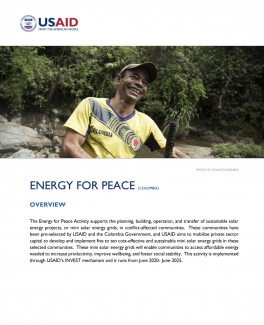OVERVIEW
The Energy for Peace Activity supports the planning, building, operation, and transfer of sustainable solar energy projects, or mini solar energy grids, in conflict-affected communities. These communities have been pre-selected by USAID and the Colombia Government, and USAID aims to mobilize private sector capital to develop and implement five to ten cost-effective and sustainable mini solar energy grids in these selected communities. These mini solar energy grids will enable communities to access affordable energy needed to increase productivity, improve wellbeing, and foster social stability. This activity is implemented through USAID’s INVEST mechanism and it runs from June 2020- June 2025. GOALS
FACILITATE PRODUCTIVITY AND GROWTH
Energy for Peace selected conflict-affect communities with clusters of producers in which to construct mini solar grids. The activity will help establish partnerships between these communities and local utility companies to ensure long-term operation and maintenance of the mini solar grids. Providing low-cost energy to the clusters of producers will increase producer income and enable producers to pay for energy. REDUCE ENERGY COSTS Energy for Peace will facilitate competitive procurement of solar equipment to lower energy costs. It will do this by standardizing the type of technology used in the solar grids developed, thus aggregating financing, equipment, transportation, and construction contracts. Lower energy costs will enable communities to purchase the energy needed and will increase profitability and attractiveness to private sector investors.
FOSTER PROJECT SUSTAINABILITY
Energy for Peace will sustain the long-term operation of solar mini grids by partnering with experienced energy utility companies. Partnering with energy utility companies is essential to the activity’s success because these companies have the technical expertise needed to maintain the mini grids, manage risks, administer the business model, and adhere to Colombia’s regulatory framework.ANTICIPATED RESULTS
- Leverage private sector resources through a blended finance model;
- Establish public-private partnerships using a Global Development Alliance (GDA);
- Connect local producers to reputable goods and services purchasers in the national economy;
- Finance, build, and commission community energy projects in conflict-affected communities; and
- Strengthen local producers’ capacity to improve production technology, productivity, and quality.
(313.32 KB)

